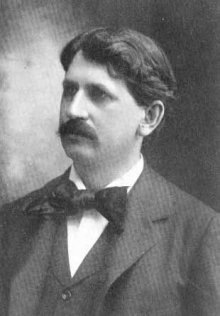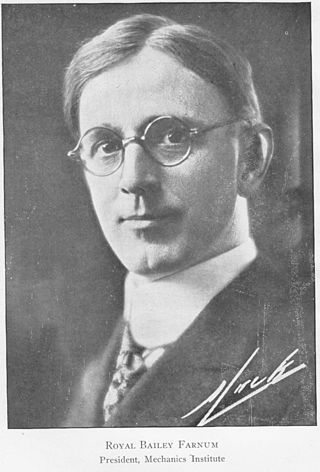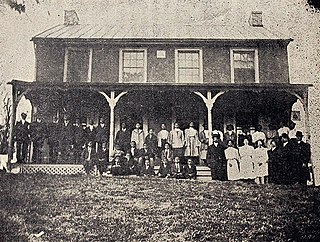Related Research Articles

Booker Taliaferro Washington was an American educator, author, orator, and adviser to several presidents of the United States. Between 1890 and 1915, Washington was the dominant leader in the African-American community and of the contemporary Black elite. Washington was from the last generation of black American leaders born into slavery and became the leading voice of the former slaves and their descendants. They were newly oppressed in the South by disenfranchisement and the Jim Crow discriminatory laws enacted in the post-Reconstruction Southern states in the late 19th and early 20th centuries.

Urbana is a city in and the county seat of Champaign County, Ohio, United States, about 34 miles (55 km) northeast of Dayton and 41 miles (66 km) west of Columbus. The population was 11,115 at the 2020 census. It is the principal city of the Urbana micropolitan area. Urbana was laid out in 1805, and for a time in 1812 was the headquarters of the Northwestern army during the War of 1812. It is the burial place of the explorer and Indian fighter Simon Kenton. The city was home to Urbana University and Curry Normal and Industrial Institute, a school for African American students.

In the 1860s, the Copperheads, also known as Peace Democrats, were a faction of the Democratic Party in the Union who opposed the American Civil War and wanted an immediate peace settlement with the Confederates.
The Erie Railroad was a railroad that operated in the Northeastern United States, originally connecting Pavonia Terminal in Jersey City, New Jersey, with Lake Erie at Dunkirk, New York. The railroad expanded west to Chicago following its 1865 merger with the former Atlantic and Great Western Railroad, also known as the New York, Pennsylvania and Ohio Railroad. Its mainline route proved influential in the development and economic growth of the Southern Tier of New York state, including the cities of Binghamton, Elmira, and Hornell. The Erie Railroad repair shops were located in Hornell and was Hornell's largest employer. Hornell was also where Erie's mainline split into two routes with one proceeding northwest to Buffalo and the other west to Chicago.

Braxton Bragg Comer was an American politician who served as the 33rd governor of Alabama from 1907 to 1911, and a United States senator in 1920. As governor, he achieved railroad reform, lowering business rates in Alabama to make them more competitive with other states. He increased funding for the public school system, resulting in more rural schools and high schools in each county for white students and a rise in the state's literacy rate.

The Ball brothers were five American industrialists and philanthropists who established a manufacturing business in New York and Indiana in the 1880s that was renamed the Ball Corporation in 1969. The Ball brothers' firm became a global manufacturer of plastic and metal food and beverage containers as well as a manufacturer of equipment and supplier of services to the aerospace industry. In addition to the brothers' manufacturing business, they were also noted for their philanthropy and community service. Earnings from their business ventures provided the financial resources to support a number of other projects in the community of Muncie, Indiana, and elsewhere. Most notably, the brothers became benefactors of several Muncie institutions including Ball State University, Ball Memorial Hospital, the YMCA, Ball stores department store, and Minnetrista. The Ball Brothers Foundation, established in 1926, continues the family's philanthropic interests.

James Edwin Campbell was an American educator, school administrator, newspaper editor, poet, and essayist. Campbell was the first principal of the West Virginia Colored Institute from 1892 until 1894, and is considered by the university as its first president.
Wilbur Lang Schramm was a scholar and "authority on mass communications". He founded the Iowa Writers' Workshop in 1935 and served as its first director until 1941. Schramm was hugely influential in establishing communications as a field of study in the United States, and the establishing of departments of communication studies across U.S. universities. Wilbur Schramm is considered the founder of the field of Communication Studies. He was the first individual to identify himself as a communication scholar; he created the first academic degree-granting programs with communication in their name; and he trained the first generation of communication scholars. Schramm's mass communication program in the Iowa School of Journalism was a pilot project for the doctoral program and for the Institute of Communications Research, which he founded in 1947 at the University of Illinois at Urbana–Champaign, now housed in the UIUC College of Media. At Illinois, Wilbur Schramm set in motion the patterns of scholarly work in communication study that continue to this day.

Frank Wakeley Gunsaulus was a noted preacher, educator, pastor, author and humanitarian. Famous for his "Million Dollar Sermon" which led Philip Danforth Armour to donate money to found Armour Institute of Technology where Gunsaulus served as president for its first 27 years. Gunsaulus lived in Chicago for 34 years where he was pastor of Plymouth Church (1887–99) and Central Church from 1899 until two years before his death. He was a prominent figure in Chicago's social, educational, and civic improvements. In 1893, he was named first president of Armour Institute of Technology. His extraordinary energy, masterful oratory skills, and intellectual talents influenced the city's spiritual, educational, cultural, and civic development for decades.

Royal Bailey Farnum was an American art educator who served in administrative roles in various public and private educational institutions in Massachusetts, New York, Ohio, and Rhode Island during the first half of the 20th century.

The National Afro-American Council was the first nationwide civil rights organization in the United States, created in 1898 in Rochester, New York. Before its dissolution a decade later, the Council provided both the first national arena for discussion of critical issues for African Americans and a training ground for some of the nation's most famous civil rights leaders in the 1910s, 1920s, and beyond.

Western University (Kansas) (1865–1943) was a historically black college (HBCU) established in 1865 (after the Civil War) as the Quindaro Freedman's School at Quindaro, Kansas, United States. The earliest school for African Americans west of the Mississippi River, it was the only one to operate in the state of Kansas.

Second Baptist Church is a historic church building in the village of Mechanicsburg, Ohio, United States. Constructed in the mid-19th century, it is the oldest church in the village, and it has been named a historic site.
Elmer Samuel Imes was an internationally renowned American physicist who made important contributions in quantum, demonstrating for the first time that Quantum Theory could be applied to the rotational energy states of molecules, as well as the vibration and electronic levels, Imes' work provided an early verification of Quantum Theory, and his spectroscopy instrumentation inventions, which include one of the earliest applications of high resolution infrared spectroscopy led to development of the field of study of molecular structure through infrared spectroscopy; he was also the second African American to earn a Ph.D. in physics and the first in the 20th century. He was among the first known African-American scientists to make important contributions to modern physics, others' prior work unrecorded or uncredited. While working in industry, he gained four patents for instruments to be used for measuring magnetic and electric properties. As an academic, he developed and chaired the department of physics at Fisk University, serving from 1930 to 1941.

Edward Thomas Demby was an African-American bishop and author. Ordained as a priest in the Episcopal Church of the United States and later a suffragan bishop in the Diocese of Arkansas and the Southwest, Demby worked against racial discrimination and for interracial harmony, both within and outside of his church.
Ralph Currier Davis was an American industrial and consulting engineer, Professor of Business Organization at Ohio State University, and organizational theorist. He is known for his work on top management, especially his 1951 extension of Henri Fayol's work.

The Downingtown Industrial and Agricultural School (DIAS) was a school for African Americans in Chester County, Pennsylvania from 1905 until 1993. Its motto was "Self help through self work". It was located in what is now East Brandywine Township.
Haygood Seminary, also known as Haygood Academy, was a seminary near Washington, Arkansas, United States. It was established by the Colored Methodist Episcopal Church to train African Americans in Arkansas for a career in the clergy. It was one of the first such institutions established by the CME Church. In 1927, the school relocated to Jefferson County, Arkansas, where it operated as Arkansas-Haygood Industrial College before closing during World War II.
George F. Richings (1852–1915) was an author and lecturer who documented African American schools and educators, as well as other successful African Americans. He was white.
Central Mississippi College was a segregated school for African American students established in 1893 by Baptist associations in Kosciusko, Mississippi, U.S. The school served in many capacities, including in its early history as a grammar school, a high school, and a normal school; and in later history it was a junior college.
References
- ↑ Meyer, Mary (1993-02-19). "Researcher tracking down story of Delaware's first black teacher". The Delaware Gazette. p. 1. Retrieved 2023-09-21.
- ↑ Curry, Elmer W. B. (1907). A Story of the Curry Institute, Urbana, Ohio. The Institute.
- ↑ Middleton, Evan P. (1917). History of Champaign County, Ohio: Its People, Industries and Institutions. B.F. Bowen. pp. 576–579.
- 1 2 Curry, Elmer W. B. (1907). A Story of the Curry Institute, Urbana, Ohio. The Institute.